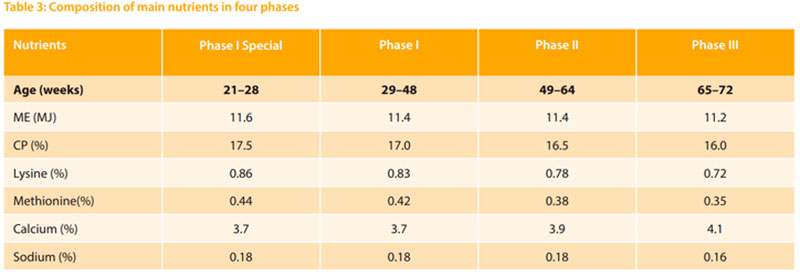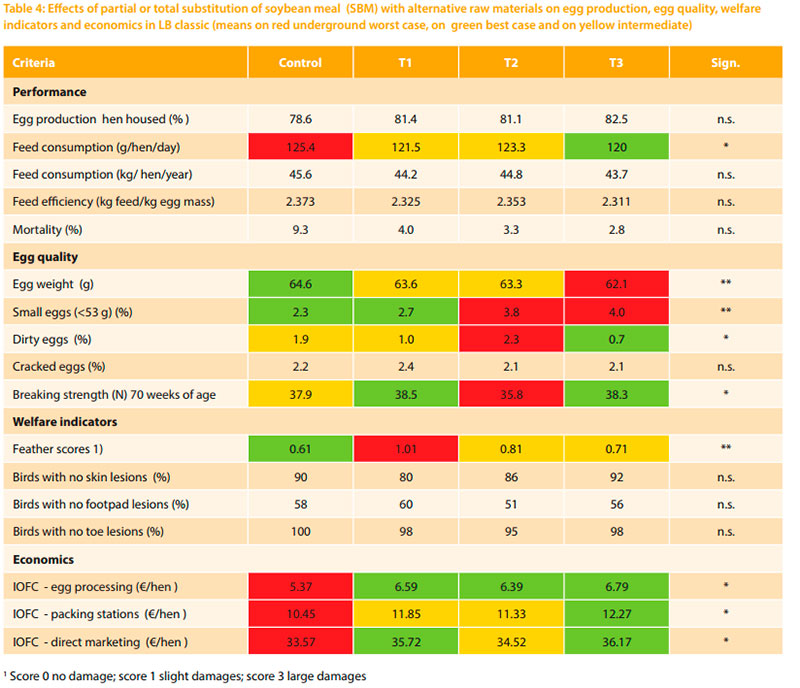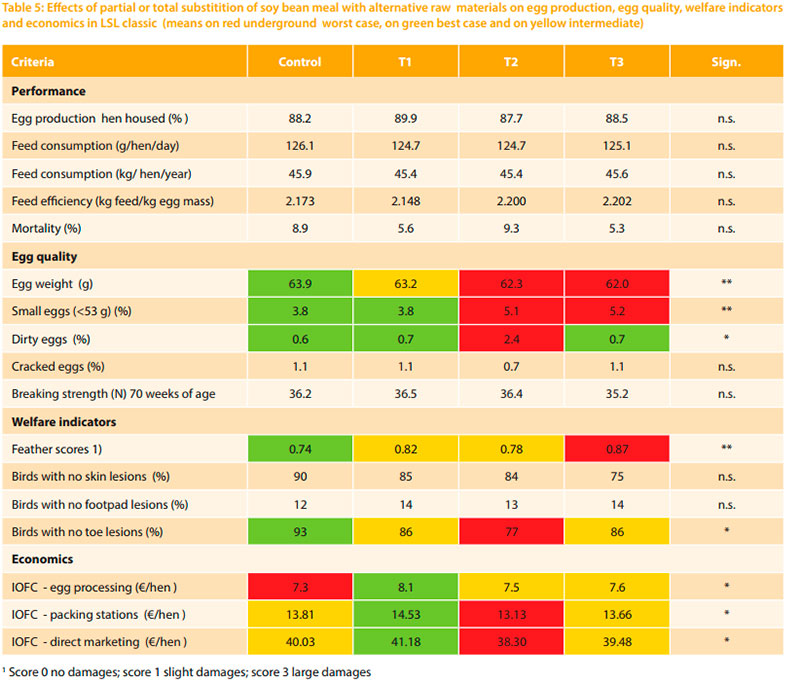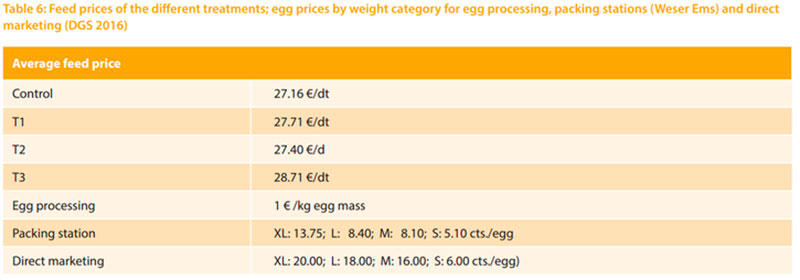Abstract
Partial and total substitution of soybean meal by alternative sources of protein, such as sunflower meal and rape seed meal from extracted or extruded rape seed, was investigated using a white and a brown commercial layer hybrid. The control diet was a conventional layer diet containing 16% non-GMO HP soybean meal and 8% dried distillers’ grain with solubles (DDGS). Three different substitution treatments were used: partial substitution using small proportions of rape seed products and sunflower flower meal (T1), total substitution of soybean meal using rape seed products (T2) and sunflower meal (T3) as main protein sources. The four treatments (control, T1, T2 and T3) were randomly assigned to the pens. Egg production and egg quality, welfare indicators and economic results were assessed for a laying period from 19 to 72 weeks of age. Despite higher mortality, LSL had higher hen-housed egg production than LB. Within lines the dietary treatments showed no significant effect on egg production, feed efficiency and mortality. Egg weight was lower in the treatments with replacement of SBM. There was no effect of treatments on skin and footpad lesions, but the control hens showed better feather condition. Income over feed cost was highest in T1 (partial substitution of soybean meal) under three different marketing scenarios. The control would have produced better economic results if cheaper GMO soybean meal had been used.
Keywords
antibiotic resistance, superbugs, livestock production, public health, growth promoters, food animalsCo-Authors
J. Hartmann, R. Schreiter und N. Wolff
Introduction
Soybean meal is the most widespread source of protein in poultry diets worldwide. Most of the soybean meal used in Europe is imported from the USA and Brazil. The use of imported soybean meal is criticized for its high environmental costs (transforming rainforest into arable land, energy use for processing and transport). Hence attempts are made to replace imported soya by locally grown alternative feedstuffs, such as peas, faba beans, lupines, rapeseed meal, sunflower meal or Dried Distillers Grains with Solubles (DDGS). The inclusion of these materials5 Vol. 51(2), December 2017 | LOHMANN Information in poultry diets is however limited for their content of anti-nutritive substances, low levels of sulphur-containing amino acids, low digestibility of protein or high levels of crude fber. Maximum recommended inclusion rates for common alternatives of soybean meal and causes of the restriction are shown in Table 1. Considering the limited levels of inclusion, at least 3 to 4 different alternative feedstuffs have to be combined should soybean meal be totally replaced. The effect of such combinations on digestibility and metabolism and thus on feed intake, egg production, health and egg quality cannot be predicted and needs to be verifed in feeding experiments. The aim of the present experiment was therefore to substitute soybean meal partially or entirely with different combinations of alternative feedstuffs. Since laying hens may differ in their response to alternative diets, the experiment was carried out with a white-egg and a brownegg commercial hybrid.
Materials and methods
A total of 1320 hens, 600 Lohmann Selected Leghorn (LSL) classic and 720 Lohmann Brown (LB) classic were used. All birds were raised from day-old up to 18 weeks of age in deep litter pens at the Experimental Poultry Farm of Bavaria, Kitzingen, Germany. The birds were not beak trimmed. At 19 weeks of age the pullets were transferred to a force ventilated layer house with windows. The layer house was subdivided in 44 deep litter pens of 4.07 m² each. 30 birds (7.4 birds per m²) were housed in each pen; 24 pens were stocked with LB and 20 pens with LSL. Four experimental diets, a control diet and three different substitution treatments, with 11 replicates each were randomly assigned to the pens. The control diet represented a practical diet containing 16% of HP soybean meal and 8% of DDGS as protein sources (table 2).
A control diet on the basis of soybean meal only would contain 19% of soybean meal. This hypothetical diet was used as reference for the substitution of soybean meal by other components. In treatment one (T1) 52.6% of soybean meal was replaced by 15.7% of a mixture of rapeseed meal from extracted rapeseed (RSE), rapeseed expeller (RSC) and sunflower meal (SFM). In treatment 2 (T2) soybean meal was entirely replaced with sunflower meal as main component and small amounts of DDGS, RSE extract and RSC. The substitution components in treatment 3 (T3) were based on RSE and RSC. Within each treatment a four phase feeding program was established to adjust the nutrient composition to the changing requirements of the hens (Table 3). Within the treatments and feeding phases all diets were iso-caloric, iso-nitrogen and contained the same amount of minerals and vitamins. Egg production, egg quality, mortality, feather conditions, injuries of skin and toes and economic criteria and egg income over feed cost (IOFC) were determined for a full-year laying period. Data were analyzed using a two-factorial model with line and feed treatment as main effects. Within each line, differences between dietary treatments were tested using Tukey’s multiple t-test. Treatment x strain interactions were not tested for statistical signifcance.


Results and discussion
Mean values of all criteria are shown in table 4 for LB and table 5 for LSL. LSL showed generally a higher percentage of egg production than LB with the highest egg production in T1 (89.9%). The effect of diets within lines where however, not signifcant. In LB hens in treatments T1 to T3 showed in tendency a higher performance then the control birds. This shows that LB hens responded more sensitively to the replacement of SBM than LSL. This is supported by the data of daily feed intake. There was a signifcant reduction in daily feed intake in the diets with higher proportions of rape seed products. T3 with a total of 16% of rape seed products showed the lowest daily feed intake (120 g), while T1 and T2 with 8% of rape seed products took an intermediate position between the control and T3. Why some birds dislike rape seed products and react with decreased feed intake has not been explained so far; chemical characteristics, the color, structure or taste of the feed may be involved.Feed conversion was consistently more efcient in LSL than LB layers. Mortality varied between 2.8% and 9.3% in LB and 5.3% and 9.3% in LSL, but the differences due to treatment are not signifcant due to small number of replications. In LSL the main cause of mortality was toe pecking: 31 out of 48 hens which died or had to be culled for this reason. This problem occurred in all dietary treatments and may be due to the fact that the birds were not beak-treated.
In both lines, there was a signifcant dose response on egg weight for the level of substitution of soybean meal: egg weight decreased consistently with increasing level of substitution of SBM. Low egg weight of 63.3 and 62.0 g was found in diets containing high levels of sunflower meal (T3) in LB and LSL respectively. Similar reduction in egg size was found in LB in T2 (63.3 g). Low levels of different substitutes (T1) showed an intermediate egg size of 63.6 and 63.2 g in LB and LSL respectively. The negative correlation between rate of lay and egg size is well known and also is found in this experiment, where the negative effect on egg weight is partially compensated by higher egg production. Differences in average daily egg mass or total hen-housed egg mass are therefore small, but have to be kept in perspective when calculating egg income over feed cost.

Due to reduced egg weight in non-soybean meal diets T2 and T3, the proportion of small eggs (S) increased substantially in the frst weeks of lay and the proportion of eggs in the categories large (L) and extra large (XL) at the end of the laying period was lower. Since small eggs (below 53 g) cannot be sold as table eggs, they have to be sold at a low price to processing plants. The proportion of cracked eggs was lower in LSL than in LB hens. Egg shell strength was lower in T2 (high level of sunflower meal), but the proportion of cracked eggs was not increased in this treatment. Sunflower meal increased the percentage of dirty eggs in both lines. Average feather scores differed signifcantly between feed treatments within line, but were not consistent across lines. Differences between lines could only be shown when particular areas were considered. While LSL showed more feather loss on the neck and back, more damage in the vent area was found in LB. However, most hens (93 to 79%) showed only slight feather damage (scores 0 and 1). Lower scores occurred in the control diet: only 7% of LB and 8% of LSL layers had featherless areas with more than 5 cm in diameter. In LB the highest score was found in T1 (1.01) and the lowest in the control. The deterioration of the feathers is mainly caused by vigorous feather pecking and pulling.High dietary fber has been found to reduce the risk of feather pecking. The fber content of diets in phase 1 feed was 2.8% in the control, 3.8% in T1, 5.8% in T2 and 4.8% in T3. The control diet had the best feather condition in both lines, although it had the lowest fber content. Thus, a lower level of dietary fber cannot explain feather pecking damages in the present study, but the higher feed intake of the control birds may have reduced feather pecking. Especially at the onset of lay many birds don’t eat enough to fully cover their nutritional requirement, and reduced feed intake in response to the substitution of SBM may have contributed to the development of feather pecking. In line with the feather scores, skin injuries were also less frequent in the control compared to the other dietary treatments. Injuries of the skin occurred mainly in the cloacal area and in the area of the preening gland. However, differences between lines and dietary treatments where not signifcant. The occurrence of “bumble foot” and toe lesions is often considered as a problem of nutrition. Diets which lead to wet litter have been found to increase the risk of footpad problems. In the present study there was no signifcant effect of the diet. There was a tendency of better foot conditions with T1 feed in both lines. The lines differed signifcantly in the frequency of footpad damages. The percentage of birds with intact footpads was 56.1% in LB and only 13.3% in LSL. Similar results were found for toe injuries. The proportion of birds showing no toe damage varied between 77 and 93% in LSL and 95 and 100% in LB. The effect of dietary treatments was not signifcant in LB. In LSL, T2 had the lowest proportion of birds with intact toes (77%). In both lines toe conditions were best in the control (93% of intact toes in LSL and 100 % in LB). The cause of the high frequency of toe injuries in LSL when fed sunflower meal (T2) is not known, nor is it consistent with feather scores and skin injuries. Therefore it should not be concluded from these results that sunflower meal represents a special risk for cannibalism.
Economics
The economic calculation is based on the assumption that imported non-GMO HP soybean meal is replaced by locally produced DDGS, rape seed extract, rape seed expeller, sunflower meal and maize gluten. Since non-GMO HP soybean meal is very expensive, its substitution with locally grown products leads to a substantial reduction of feed cost compared to the control diet: 1€/dt in T1, 1.31 €/dt in T2 and 1.55 €/dt in T3. Taking different egg prices into account, calculations were made for three different scenarios: eggs sold (1) to an egg processing plant (lowest price), (2) to a large-scale packing station (intermediate price), and (3) directly to the consumer (highest price). The results are shown tables 4 and 5. Independent of the egg price, egg income over feed cost (IOFC) was higher for LSL than in LB layers. The economic results with different diets also differed between lines: under all marketing scenarios, LB layers produced a higher IOFC when imported non-GMO soybean meal was replaced by alternative sources of protein: the best result was found with T3, followed by T1 and T2, and the lower egg production with the control diet in LB could not be compensated by larger eggs. In LSL the best economic result was achieved in T1 under all marketing scenarios, followed by control, T3 and T2. However, it should be kept in mind that the calculation is based on the high price of non-GMO soybean meal. With the same performance, the ranking of economic results would be reversed if ordinary GMO soybean meal were used.
Conclusions
- Total substitution of imported soybean meal with locally available sources of protein in layer diets leads to reduced daily feed intake, reduced egg weight, and more damage of feathers, skin and toes. Therefore total substitution is not recommended at present. Further experiments are required to fnd out whether disadvantages of alternative feedstuffs may be removed by adjusting nutrient density, composition of amino acids or feed additives which improve the digestibility of nutrients in these components.
- Genetic lines respond differently to alternative feedstuffs. Brown-egg layers like LB appear to be more sensitive than white-egg layers like LSL to substitution of soybean meal.
- High levels (16%) of sunflower meal produced more dirty eggs and toe damages than other diets.
- Partial substitution of non-GMO soybean meal by moderate levels of locally available substitutes (rape seed products, sunflower meal) showed similar performance in terms of egg mass and feed efciency, but minor problems of welfare related characteristics.

References
Jeroch, H., Simon, A., Zentek, J. 2012: Geflügelernährung. Verlag Eugen Ulmer, Stuttgart, Germany.Jeroch, H., Dänicke, S. 2016: Faustzahlen zur Geflügelfütterung. In: Geflügeljahrbuch 2017. Verlag Eugen Ulmer, Stuttgart,Germany.
Kamphues, J. 2014: Supplemente zur Tierernährung. Verlag Schaper, Hannover, Germany










